|
IRAS 18286-0959 -- a water
fountain star.
-
The ATCA/VLA OH 1612 MHz maser survey to the northern sky found 286 OH-masing
objects, 161 of them are new detections. Three water fountain stars were
also observed: IRAS 18460-0151(img58), IRAS 18286-0959(img54) and IRAS 18450-0148(img57).
(from Sevenster et al., 2001A&A...366..481S)
(figure: OH 1612 MHz maser line profile
of IRAS 18460-0151. X: km/s, Y: Jy)

-
IR counterparts of all 23 masing source and 18 very red objects are
identified in Spitzer/GLIMPSE images at 3.6, 4.5, 5.8, and 8.0 μm. Two
new water fountain stars (IRAS
18286-0959, IRAS 18460-0151) and an SiO maser with companion nebulosity (IRAS 19027+0517) are found by Nobeyama 45m
observations. The non-detection of HCO+, J=1-0 for the H2O maser sources
demonstrates that they are not young stellar objects. The H2O masers of IRAS
18286 covering -50 ~ 160 km/s and so,Vexp = ~105 km/s,
Vlsr = ~55 km/s.
(from Deguchi et al., 2007ApJ...664.1130D)
(figure: H2O masers of IRAS 18286-0959)
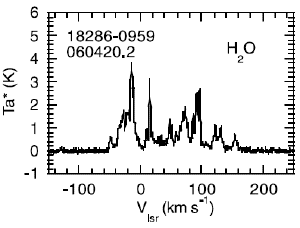
- (Yung et al., arXiv:1108.2104)
Facts: They found clear precessing bipolar outflows from the water fountain star IRAS 18286-0959 by VLBA mapping of 22 GHz H2O masers. This is the second source (after W 43A) with its twisted bipolar outflow discovered through H2O mapping. The H2O maser velocity ranges are -50 to 150 km/s.
Results: They suggested two pairs of bipolar jets with different origins to explain the data -- double helix. They also proposed that the two pair of jets are produced by the same star that is moving in space and the two pair of jets were ejected at different times.
(figs: left -- H2O maser spectra at different epochs: a) 2006 Apr. 20; b) 2008 Apr. 30, c) 2010 Apr. 2; left middle -- maser spots; right middle -- proper motions; right -- two processing bipolar jets models.)
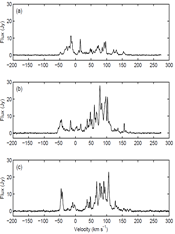 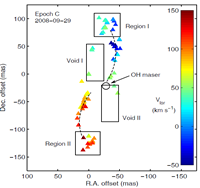 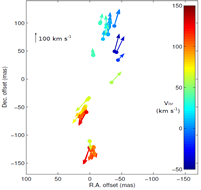 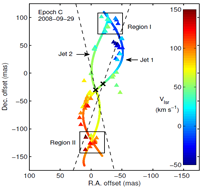
|
|
![]()